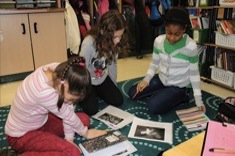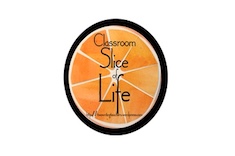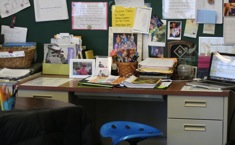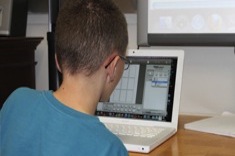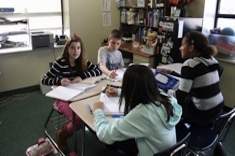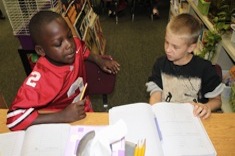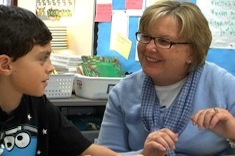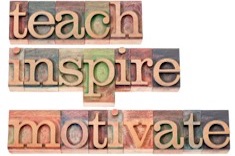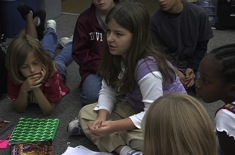5th
Latest Content
Cooking Up Interest in Words with Fifth Graders
Maria Caplin continues her series on sparking vocabulary learning, this time highlighting fun activities.
Shared Reading in the Intermediate Grades
Shari Frost explains why shared reading is valuable for older students, with examples of the practice in the intermediate grades.
Slice of Life: Challenging Student Writers
Katherine Sokolowski brings the popular web “slice of life” challenge to her fifth-grade classroom.
Guidance and Choice in a Fifth-Grade Conference
Karen Terlecky confers with fifth grader Jillian the day after she has selected two books Jillian might enjoy reading during workshop.
Understanding the Middle East Through Children’s Literature (BOOKLIST)
Sheiks, harems, and terrorists — the stereotypes of the middle east from popular culture may not be realistic, but they sure are pervasive. Ruth Shagoury and Andie Cunningham find authentic alternative views to present to children in their new booklist.
Audioboo, QR Codes, and Authentic Reading Response
Katherine Sokolowski uses audio recordings and other tech resources to build her fifth-grade reading community.
March Book Madness
Basketball’s March Madness has many possibilities in schools. Tony Keefer tries a similar format with brackets and voting for March Book Madness.
Beyond Text Features in Nonfiction Instruction
Franki Sibberson considers how the demands of the Common Core and the complex mix of online and offline nonfiction texts are changing the skills she teaches students.
Supporting the Transition to Middle School: An Elementary Teacher’s Perspective
Maria Caplin shares how and why she began to collaborate with Gretchen Taylor, a sixth-grade teacher who would soon be the middle school teacher for some of her students.
Getting Rid of My Teacher’s Desk
Katherine Sokolowski discovers getting rid of her teacher's desk opens her mind to many new possibilities in her fifth-grade classroom.
Building a Reading Community with Edmodo
Katherine Sokolowski discovers Edmodo is a wonderful tech tool for helping her fifth graders become more independent and supportive of everyone’s reading choices.
Weaving Word Study into Writing Workshop in 5th Grade
Maria Caplin describes how she integrates word study with intermediate students in writing workshops.
Highlighting Language in a Writing Conference
Karen Terlecky confers with fifth grader Nora about her evocative language during writing workshop.
The Power of Read-Aloud Notebooks
Karen Terlecky shares the process of launching and sustaining read-aloud notebooks with fifth graders.
From “Show Me the Lessons” to Sustainable Planning (Part 4 of the Opinion/Argument Writing Series)
This is the final installment in Heather Rader's series on argument and opinion writing in the intermediate grades.
Peer Conferring: The Release Phase
Amanda Adrian concludes her series on peer conferring, analyzing the value of students working on their own after instruction and practice.
Touchy Topics for Opinion/Argumentative Writing
When students take a stand in writing, they will almost inevitably bring up touchy topics. Heather Rader considers the challenge in part 3 of her opinion/argumentative writing series.
Helping Richard Revise
Karen Terlecky coaxes Richard to cut extraneous material from his writing by highlighting the strengths of his writing first in this video from her fifth grade classroom.
A Graphic Novels Unit in 5th Grade
Katherine Sokolowski designs a graphic novels unit for her fifth graders, and is surprised by how much the genre delights them.
Thank You For Arguing
In the second installment of our teaching argument/opinion writing series, Heather Rader uses a continuum dialogue and modeled writing with intermediate students.
It’s Not About the Tool — It’s About the Learning
Maria Caplin explains step by step how she integrated the use of iPods into her writing workshop, helping students use them to record notes and create persuasive texts.
Fun in January: A Mock Caldecott Unit
Katherine Sokolowski discovers a seven-day Mock Caldecott unit is a fun way to build a reading community by predicting the winners, and Skyping with another class to share results.
I Love a Good Argument
As Heather Rader works with teachers and teams on opinion/argumentative writing, she’s considering the anatomy of an argument and engaging ways to teach it.
Catching Up with Tommy
Karen Terlecky meets with Tommy, a boy who has flown under the radar for a few weeks in her fifth-grade reading workshop.
Choice and Reading Response
As more intermediate classrooms become departmentalized, grades 4-6 teachers find they are dealing with 80 or more reading response logs instead of 25-30 each week. Katherine Sokolowski tackles the issue of providing personal response to readers and still having time for everything else.
Teaching the Rule of Three to Writers
Aimee Buckner finds that teaching the rule of three to young writers adds variety to student texts.
Writers Inspiring Writers
Melissa Styger invites colleagues and family members into the classroom to share their writing process with students.
Rethinking Mrs. T Letters
Karen Terlecky reconsiders one of her favorite writing assignments.
Peer Conferring: The “Try It On” Phase
Amanda Adrian continues her series on how teachers can scaffold and model peer conferring. In this installment, Amanda uses the fishbowl technique with students.
Book Matchmaker: Fairy Tales for Older Readers
Renew older students' interest in fantasy and fairy tales with these suggestions of recent titles from Franki Sibberson.
Browse Content By
Type
Category
- Assessment Tools
- Big Fresh Archives
- Booklists
- Choice Numeracy
- Classroom Design
- Common Core
- Community Building
- Conferring
- Content Literacy
- Digital Literacy
- English Language Learners
- Equity
- Family Relations
- Free Samples
- Guiding Groups
- Leadership
- Literacy Coaches
- Mentor Texts
- Minilessons
- New Teacher Mentors
- Podcasts
- Poetry
- Quote Collections
- Reading Strategies
- Self Care
- Struggling and Striving Learners
- Talking and Listening
- Teacher Study Groups
- Teaching Reading
- Teaching Writing
- Word Study and Vocabulary
Author
- Melissa Quimby
- Nawal Qarooni
- Gwen Blumberg
- Julie Cox
- The Lead Learners
- Hannah Tills
- Josie Stewart
- Ruth Metcalfe
- Mallory Messenger
- Becca Burk
- Jodie Bailey
- Vivian Chen
- Mary Brower
- Tiffany Abbott Fuller
- Stephanie Affinito
- Ruth Ayres
- Leigh Anne Eck
- Heather Fisher
- Shari Frost
- Julie Johnson
- Suzy Kaback
- Gigi McAllister
- Shirl McPhillips
- Melanie Meehan
- Cathy Mere
- Debbie Miller
- Tara Barnett and Kate Mills
- Tammy Mulligan
- Dana Murphy
- Bitsy Parks
- David Pittman
- Brenda Power
- Heather Rader
- Matt Renwick
- Mandy Robek
- Christy Rush-Levine
- Gretchen Schroeder
- Jen Schwanke
- Brian Sepe
- Katherine Sokolowski
- Stella Villalba
- Jennifer Vincent
Grade Level
Choice Literacy Membership
Articles
Get full access to all Choice Literacy article content
Videos
Get full access to all Choice Literacy video content
Courses
Access Choice Literacy course curriculum and training


